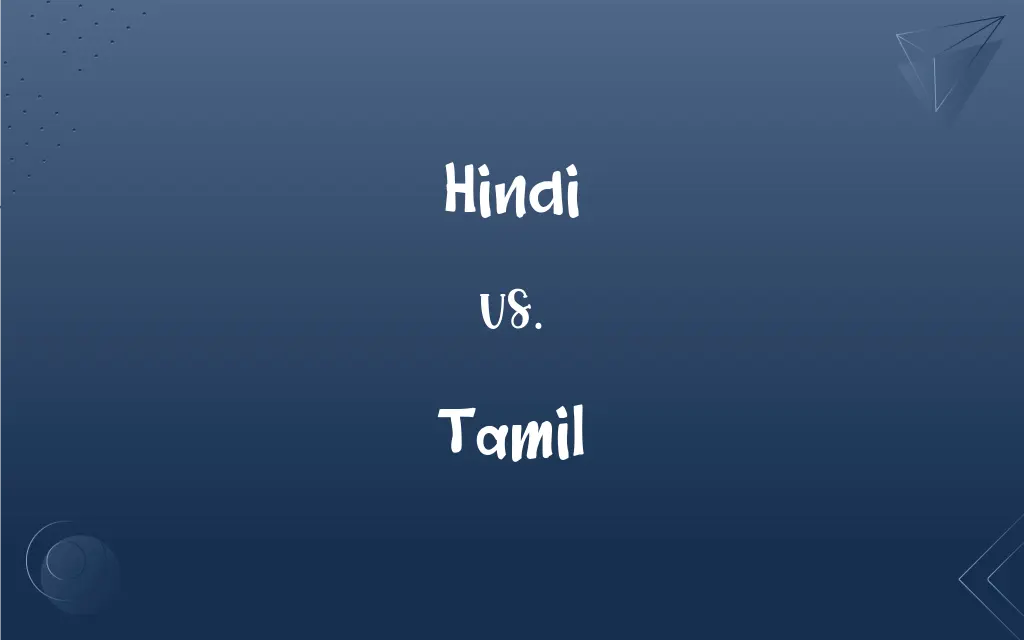Hindi vs. Tamil: What's the Difference?
Edited by Aimie Carlson || By Janet White || Updated on September 27, 2023
Hindi is a language predominantly spoken in Northern India with Devanagari script, while Tamil, using the Tamil script, is prevalent in Tamil Nadu, India, and Sri Lanka.

Key Differences
Hindi and Tamil are significant languages, each presenting a rich tapestry of culture, history, and linguistic complexity. Hindi, recognized as one of the official languages of India, is predominantly spoken in Northern India. It utilizes the Devanagari script, a script notable for its distinctive horizontal line running along the top of full letters. Hindi is a representative of the Indo-Aryan group of languages, reflecting the diverse linguistic and cultural heritage of the northern regions of the subcontinent.
Conversely, Tamil is a Dravidian language predominantly spoken in Tamil Nadu, India, and Sri Lanka. It employs the Tamil script, marked by its uniqueness and age, believed to have evolved over the centuries. Tamil is one of the longest-surviving classical languages in the world, its literary tradition extending over two thousand years. This language is deeply interwoven with the cultural, historical, and academic fabric of the Tamil-speaking population, holding a position of immense significance.
While Hindi’s phonology, syntax, and vocabulary are influenced by Sanskrit, showcasing a plethora of sounds and grammatical structures, Tamil showcases a different phonological system and grammar, indicative of the Dravidian linguistic characteristics. Hindi has experienced the influence of Persian, Arabic, and English, enriching its lexicon, while Tamil’s lexical richness is augmented by its extensive and ancient literary tradition, offering a wealth of classical and modern works.
The geographical locales where Hindi and Tamil are spoken are starkly different, reflecting the varied topographies and cultural landscapes of India. Hindi is a bridge language in the diverse multilingual tapestry of Northern India, acting as a linchpin in the communication matrix of the region. Meanwhile, Tamil is a pillar of the Dravidian culture and heritage, echoing the melodies, philosophies, and wisdom of the Tamil civilization.
In essence, Hindi and Tamil, with their distinct scripts, phonological systems, and cultural connotations, stand as proud bearers of the immense linguistic diversity of the Indian subcontinent. They are mirrors to the multifaceted civilizations and histories they represent, each narrating a unique story of evolution, resilience, and richness.
ADVERTISEMENT
Comparison Chart
Language Family
Belongs to the Indo-Aryan group of the Indo-European language family.
A Dravidian language.
Script
Uses the Devanagari script.
Uses the Tamil script.
Geographical Area
Predominantly spoken in Northern India.
Predominantly spoken in Tamil Nadu, India, and Sri Lanka.
Literary Tradition
Has a rich literary tradition influenced by Sanskrit, Persian, Arabic, and English.
Possesses an extensive, ancient literary tradition, over 2000 years old.
Phonological System
Features a diverse array of sounds and is characterized by a significant number of phonemes.
Features a different set of phonemes, indicative of Dravidian linguistic traits.
ADVERTISEMENT
Hindi and Tamil Definitions
Hindi
Belongs to the Indo-Aryan group.
Hindi is part of the Indo-Aryan languages, showing influence from Sanskrit.
Tamil
Recognized as a classical language.
Tamil is revered as one of the longest-surviving classical languages in the world.
Hindi
Has official status in India.
Hindi, along with English, is used for central government administrative purposes.
Tamil
Utilizes the Tamil script.
Tamil script, distinct and unique, is used for writing Tamil.
Hindi
Utilizes the Devanagari script.
Hindi is written in the distinct Devanagari script with a horizontal line on top.
Tamil
A classical Dravidian language.
Tamil has a rich and ancient literary tradition.
Hindi
Rich in literary works.
Hindi literature encompasses a range of genres and eras, offering a diverse reading experience.
Tamil
Has a rich literary tradition.
The extensive literary works in Tamil include both classical and modern compositions.
Hindi
A prominent language of Northern India.
Hindi is one of the official languages of India.
Tamil
A member of a Dravidian people of southern India and northern Sri Lanka.
Hindi
A group of vernacular Indic dialects spoken in northern India.
Tamil
The Dravidian language of the Tamil.
Hindi
The literary and official language of northern India that is based on these dialects. It is written in Devanagari and uses Sanskrit as a resource language.
Tamil
Of or relating to the Tamil or their language or culture.
Hindi
The name given by Europeans to that form of the Hindustani language which is chiefly spoken by native Hindus. In employs the Devanagari character, in which Sanskrit is written.
Tamil
Of or pertaining to the Tamils, or to their language.
Hindi
The most widely spoken of modern Indic vernaculars; spoken mostly in the north of India; along with English it is the official language of India; usually written in Devanagari script
Tamil
One of a Dravidian race of men native of Northern Ceylon and Southern India.
Hindi
Of or relating to or supporting Hinduism;
The Hindu faith
Tamil
A member of the mixed Dravidian and Caucasoid people of southern India and Sri Lanka
Tamil
The Dravidian language spoken since prehistoric times by the Tamil people in southern India and Sri Lanka
Tamil
Of or relating to a speaker of the Tamil language or the language itself;
The Tamil Tigers are fighting the Sinhalese in Sri Lanka
Tamil agglutinative phrases
Tamil
Predominantly spoken in Tamil Nadu and Sri Lanka.
The Tamil-speaking population in Tamil Nadu and Sri Lanka is significant.
FAQs
Where is Tamil mainly spoken?
Tamil is mainly spoken in the Indian state of Tamil Nadu and in Sri Lanka.
Are Hindi and Tamil from the same language family?
No, Hindi is an Indo-Aryan language, while Tamil is a Dravidian language.
Do Hindi and Tamil use the same script?
No, Hindi uses the Devanagari script, and Tamil uses the Tamil script.
Is Tamil recognized as a classical language?
Yes, Tamil is recognized as a classical language due to its rich literary tradition and ancient origins.
Which language has a longer literary history?
Tamil has a longer literary history, with texts dating back over two thousand years.
How many people speak Hindi?
Hindi is the first language of more than 340 million people and is also spoken as a second language by millions more.
Is Hindi influenced by other languages?
Yes, Hindi has been influenced by Sanskrit, Persian, Arabic, and English.
How many people speak Tamil?
Tamil is spoken by approximately 75 million people worldwide.
Is Hindi one of the official languages of India?
Yes, Hindi, in the Devanagari script, is one of the official languages of India.
Is learning Tamil difficult?
The difficulty of learning Tamil varies from person to person and depends on the learner's native language and language learning aptitude.
Can Hindi and Tamil speakers understand each other’s languages?
Generally, no. Hindi and Tamil are distinct languages with different scripts, grammar, and vocabulary.
Is Hindi spoken predominantly in North India?
Yes, Hindi is predominantly spoken in the northern regions of India.
Are there dialect variations in Hindi and Tamil?
Yes, both Hindi and Tamil have various dialects, reflecting regional variations in pronunciation, vocabulary, and grammar.
Are Hindi and Tamil used in governmental functions in their respective regions?
Yes, Hindi is used in governmental functions in Hindi-speaking regions, and Tamil is used in Tamil Nadu, India, and Northern and Eastern provinces of Sri Lanka.
Are there universities offering courses in Hindi and Tamil languages?
Yes, many universities around the world offer courses in both Hindi and Tamil languages.
About Author
Written by
Janet WhiteJanet White has been an esteemed writer and blogger for Difference Wiki. Holding a Master's degree in Science and Medical Journalism from the prestigious Boston University, she has consistently demonstrated her expertise and passion for her field. When she's not immersed in her work, Janet relishes her time exercising, delving into a good book, and cherishing moments with friends and family.
Edited by
Aimie CarlsonAimie Carlson, holding a master's degree in English literature, is a fervent English language enthusiast. She lends her writing talents to Difference Wiki, a prominent website that specializes in comparisons, offering readers insightful analyses that both captivate and inform.































































